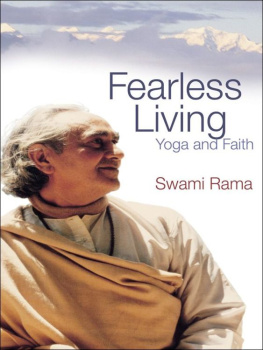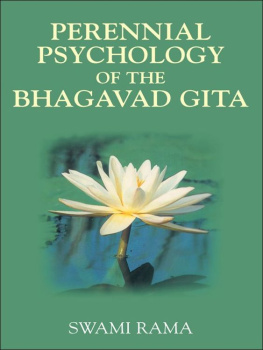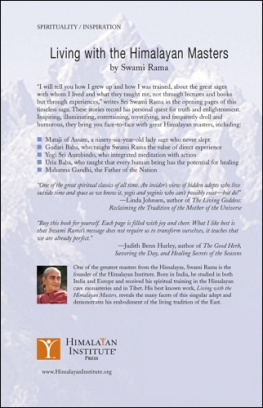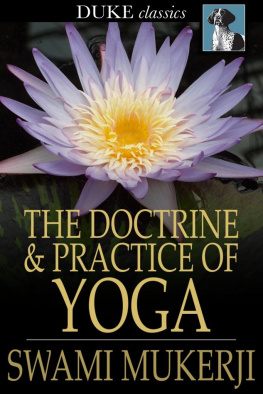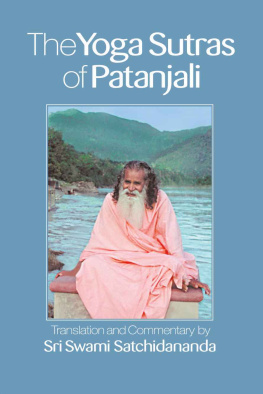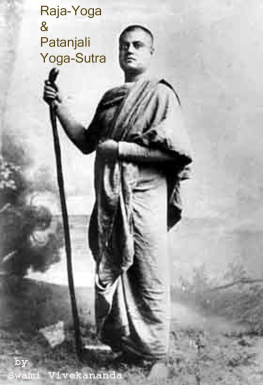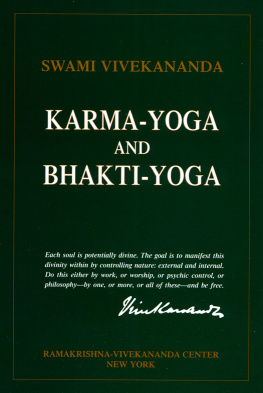Swami Rama - Fearless Living: Yoga and Faith
Here you can read online Swami Rama - Fearless Living: Yoga and Faith full text of the book (entire story) in english for free. Download pdf and epub, get meaning, cover and reviews about this ebook. year: 2009, publisher: Himalayan Institute Press, genre: Religion. Description of the work, (preface) as well as reviews are available. Best literature library LitArk.com created for fans of good reading and offers a wide selection of genres:
Romance novel
Science fiction
Adventure
Detective
Science
History
Home and family
Prose
Art
Politics
Computer
Non-fiction
Religion
Business
Children
Humor
Choose a favorite category and find really read worthwhile books. Enjoy immersion in the world of imagination, feel the emotions of the characters or learn something new for yourself, make an fascinating discovery.
- Book:Fearless Living: Yoga and Faith
- Author:
- Publisher:Himalayan Institute Press
- Genre:
- Year:2009
- Rating:3 / 5
- Favourites:Add to favourites
- Your mark:
- 60
- 1
- 2
- 3
- 4
- 5
Fearless Living: Yoga and Faith: summary, description and annotation
We offer to read an annotation, description, summary or preface (depends on what the author of the book "Fearless Living: Yoga and Faith" wrote himself). If you haven't found the necessary information about the book — write in the comments, we will try to find it.
Fearless Living: Yoga and Faith — read online for free the complete book (whole text) full work
Below is the text of the book, divided by pages. System saving the place of the last page read, allows you to conveniently read the book "Fearless Living: Yoga and Faith" online for free, without having to search again every time where you left off. Put a bookmark, and you can go to the page where you finished reading at any time.
Font size:
Interval:
Bookmark:
Join Swami Rama, the late founder of the Himalayan Institute, on the adverture in faith that was his life. Born in Northern India in 1925, this remarkable man made tremendous spiritual inroads to Wester culture. He helped spark the holistic health movement and poineered stress reduction techniques that are routinely taught in hospitals across Europe and the Americas. Fearless Living: Yoga and Faith is a sampling of Swami Ramas many anecdotes, true stories oof faith, protection, and revelation as he actually lived them.
Each chapter addresses such challenging faith-related subjects as fearlessness, miracles of healing, and the astonishing abilitites of the one-pointed mind. This is a book filled with stories of sages and saints who possess phenomenal siddhis, or supernatural powers. Some of its storiesmysterious beings who guide lost travelers in the Himalayas, a clever saga who changes one form of matter into another, a master who heals a boy suffering from small poxwill amaze you. But Swami Rama insisted that such gifts are trite. The real value of the practices he tauch are health, tranquility, and enlightened awareness.
Fearless Living
Yoga and Faith
Also by Swami Rama
BOOKS
Living with the Himalayan Masters
The Art of Joyful Living
Love Whispers
Meditation and Its Practice
The Royal Path: Practical Lessons on Yoga
Happiness Is Your Creation
Love and Family Life
A Practical Guide to Holistic Health
Path of Fire and Light, Vols. I and II
Spirituality: Transformation Within & Without
The Valmiki Ramayana Retold in Verse, Vols. I and II
Book of Wisdom: Ishopanishad
Celestial Song/Gobind Geet
Choosing a Path
Freedom from the Bondage of Karma
Perennial Psychology of the Bhagavad Gita
Wisdom of the Ancient Sages: Mundaka Upanishad
Japji: Meditation in Sikhism
Nitnem: Spiritual Practices of Sikhism
Philosophy/Faith of Sikhism
Sikh GurusLives and Teachings
CO-AUTHORED BY SWAMI RAMA
Joints and Glands Exercises
Meditation and Christianity
Science of Breath
Yoga and Psychotherapy
AUDIO & VIDEO
Guided Meditation for Beginners
A Guide to Intermediate Meditation
A First Step Toward Advanced Meditation
Guided Meditation for Initiates
Inner Peace in a Troubled World
Stressless Living
Spiritual Origins of Health
Finding Meaning in Life
How to Tread the Path of Superconscious Meditation
Yoga and Faith
by
Swami Rama of the Himalayas
Edited by Linda Johnsen

The Himalayan Institute Press
952 Bethany Turnpike
Honesdale, PA 18431
www.HimalayanInstitute.org
2005 The Himalayan International Institute of Yoga Science and Philosophy of the U.S.A.
09 08 07 06 05
6 5 4 3 2 1
All rights reserved. No part of this book in any manner, in whole or in part, in English or in any other language, may be reproduced or transmitted in any form or by any means, electronic or mechanical, including photocopying and recording, or by any information storage or retrieval system without prior written permission of the copyright owner.
Printed in China
Cover design by Jeanette Robertson
The paper used in this publication meets the minimum requirements of American National Standard for Information SciencesPermanence of Paper for Printed Library Materials, ANSI Z39.48-1984.
Library of Congress Cataloging-in-Publication Data
Rama, Swami, 19251996
Fearless living: yoga and faith / [by Swami Rama]; edited by Linda Johnsen.
p. cm.
ISBN-13: 978-0-89389-251-7
ISBN-10: 0-89389-251-3
1. Spiritual lifeHinduismAnecdotes. 2. Spiritual biographyIndia.
I. Johnsen, Linda, 1954 II. Title.
BL1237.32.R265 2005
294.5436dc22
2005022274
chapter one
Humble, Happy, and Wise
chapter two
Faith and Fearlessness
chapter three
The Mysterious Mind
chapter four
Miracles of Healing
chapter five
Trusting the Extraordinary
chapter six
Encounters with the Divine
chapter seven
Learning to Soar
Swami Ramas entire life was an adventure in faith. He left India with only $6 in his pocket when his guru, Indias legendary Bengali Baba, sent him to the West to introduce the world to the immense benefits of yoga. Within just a few years, his work at the Menninger Foundation in Topeka, Kansas, radically transformed our ideas about how the mind affects the body, while his books and lectures on yogic diet and exercise helped spark the Holistic Health movement. Today many of the stress-reduction techniques he pioneered are routinely taught in hospitals across Europe and the Americas, and foods he helped introduce (such as basmati rice) are staples in Western health-food stores. Meditation classes are now offered from coast to coast, since dozens of scientific studies have verified the astonishing therapeutic effect of simply sitting quietly, focusing on a mantra.
Where did this remarkable man come from? Swami Rama was born in northern India in 1925, but lost both parents at an early age. He was adopted by the yogi-saint people called Bengali Baba, a living legend in India. Raised in the cave monasteries of the Himalayan mountains, Swamiji was initiated in advanced techniques of yoga and meditation. (Years later in a lab in Topeka, he would demonstrate his complete mastery of his physiological and mental states, amazing researchers who till that time had not believed such total control of internal states was humanly possible.) In his early twenties Swamiji was named Shankaracharya of Karvirpitham, one of the most prestigious spiritual posts in all of India. He was destined, however, to teach not just in India but throughout the world. He renounced his position and returned to his spiritual master for further training in the ancient techniques of yoga. In the late 1960s Bengali Baba sent this head-strong yogi to the West not merely to teach but also to personally demonstrate how spiritual practice can unveil higher, hidden dimensions in our nature.
For those of us who studied with Swami Rama, the best times were when hed sit back and tell us about his experiences as a wandering ascetic in India, hiking in the Himalayan foothills or camping along the bank of the Narmada River. The tales of the saints and sages hed met were so incredible we could hardly believe them, having been so conditioned by our scientific culture to turn our backs on the miraculous. He pointed us toward a truth beyond belief, a higher science that any one of us could verify for ourselves, as he had done. We needed only to diligently practice the techniques for expanding the boundaries of human awareness developed by spiritual masters thousands of years ago, and reverently handed down from guru to disciple over the millennia. Swamijis own phenomenal abilities, called siddhis or supernatural powers, convinced us that his tales were true. These, he insisted, were trite gifts of the ancient tradition. The real value of our practice was health, tranquility, and enlightened awareness. If we supplemented our burgeoning faith with spiritual disciplines, we would no longer simply believe in a higher reality, we would experience it directly.
For so many of us today, trusting in a higher power isnt easy. We read about miracles that happened many years ago, when Jesus was teaching in Palestine, for example. But today most of the miracles we hear about are produced by science: miraculous new cures, new technologies, new breakthroughs. And scientists seem united in insisting there is no higher power, no ultimate meaning in life, nothing but the random reshuffling of DNA, atoms, and the void.
Next pageFont size:
Interval:
Bookmark:
Similar books «Fearless Living: Yoga and Faith»
Look at similar books to Fearless Living: Yoga and Faith. We have selected literature similar in name and meaning in the hope of providing readers with more options to find new, interesting, not yet read works.
Discussion, reviews of the book Fearless Living: Yoga and Faith and just readers' own opinions. Leave your comments, write what you think about the work, its meaning or the main characters. Specify what exactly you liked and what you didn't like, and why you think so.

